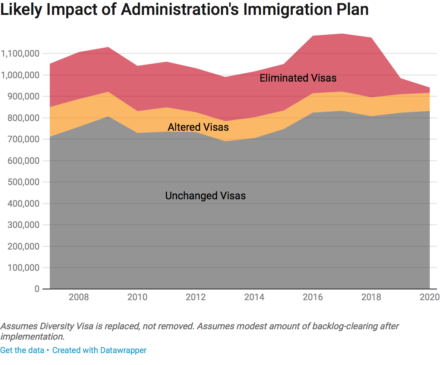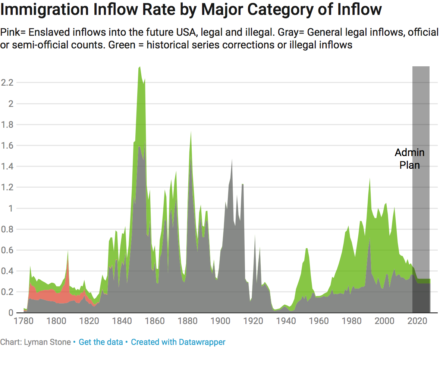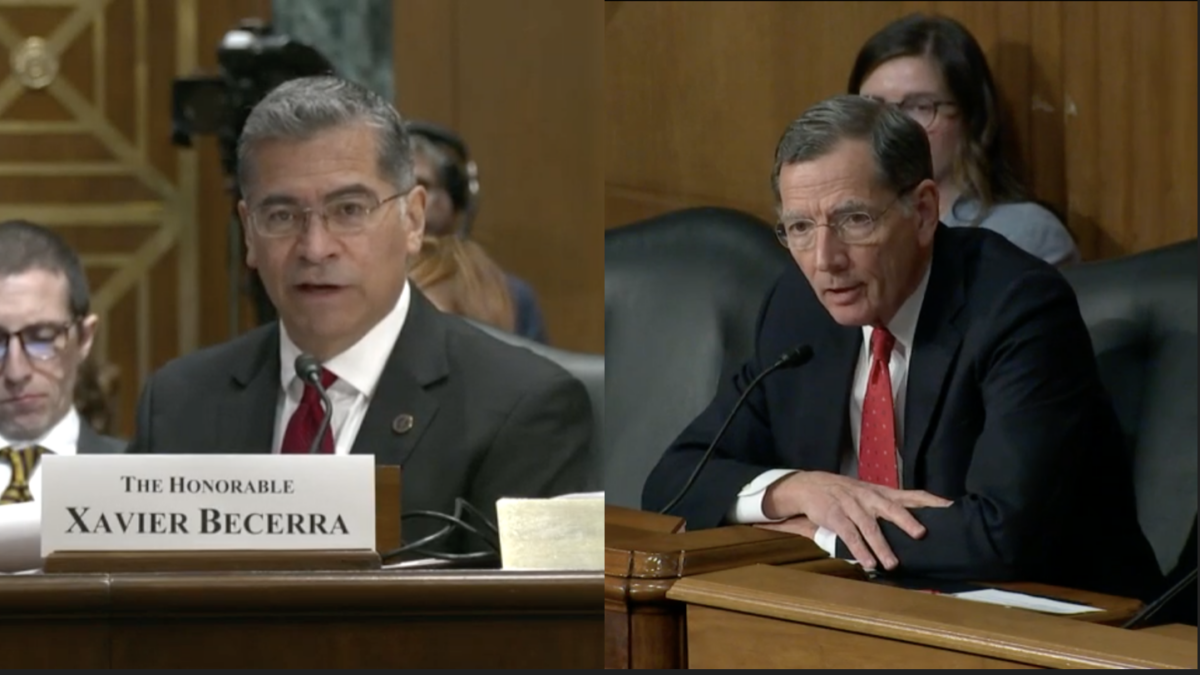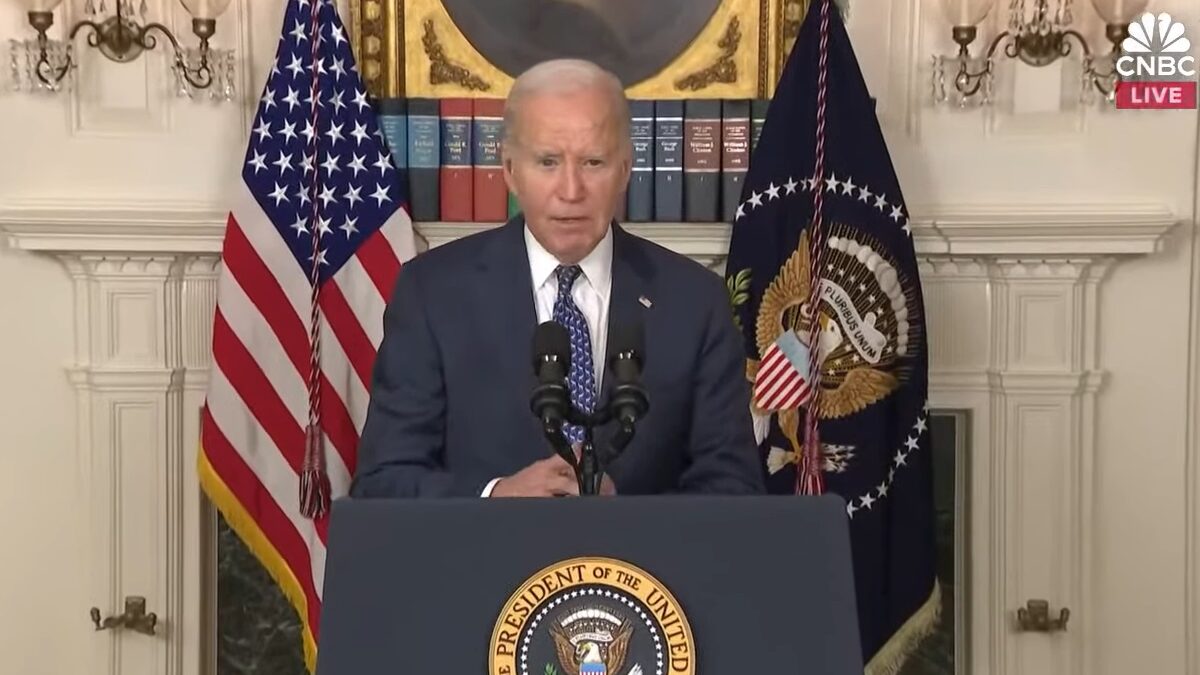
President Trump has proposed a major immigration plan that includes a path to citizenship for nearly two million protected illegal immigrants and $25 billion for a border wall, as well as other plans to achieve several of his key priorities. The details of the plan are unclear, however, and it’s all too easy to get carried away by impassioned arguments untethered from the facts.
Let’s take a look at the outlines of the president’s plan and spot the good, the bad, and the ugly.
Legal Status for Nearly 2 Million “Dreamers”
Trump has proposed the largest amnesty since President Ronald Reagan’s amnesty in the 1986 immigration reform. But instead of targeting just anyone who’s lived here long enough, as Reagan’s did, Trump’s amnesty plan targets people who came to the U.S. as children and have lived essentially their whole lives in the United States. These people, known as “dreamers,” are typically native English speakers with family already in America.
Rather than simply giving permanent residency to 690,000 current recipients of Deferred Action for Childhood Arrivals (DACA) recognized by the Obama Administration, Trump’s amnesty would open the door to legal residency for anyone who would have been eligible for DACA, whether they received it or not, which could be as many as 2 million illegal immigrants. This would be a huge concession to immigration advocates, and give them the biggest win they’ve had on immigration in over a decade.
But there’s a catch.
Reforms to Border Security
In exchange for giving immigration advocates DACA citizenship, Trump wants several things. First, he wants $25 billion for a wall. The effectiveness of physical barriers at preventing illegal immigration across land borders is hotly debated; the world’s most famous examples, like the Great Wall of China or Hadrian’s Wall, are famous precisely because they were abysmal failures. But given the clear desire of progressives to avoid serious commitments to enforcement, it’s understandable why conservatives would want a physical barrier that would be hard or expensive for progressives to tear down in the future. It’s a commitment device on future border enforcement.
Beyond that, Trump is asking for other enforcement fixes. For example, he wants more border patrol agents. On the pro side, more agents probably does mean a more secure border, and lower illegal immigration. On the con side, the border patrol is already one of the most corrupt and mismanaged (and rapidly-expanding!) agencies in the bloated federal bureaucracy, represented by a powerful and politically motivated government workers union.
The President also wants several technical changes to enforcement laws, such as the right to keep immigrants detained while they await trial, and the right to immediately deport immigrants caught entering illegally back to their home country. Both policies would indeed make it easier to secure the border, and would make getting caught by the border patrol a far worse proposition for migrants — likely dissuading some from trying to cross illegally. It’s worth noting, however, that keeping immigrants in detention can be extremely costly, as spaces in detention centers have to be financed by taxpayer money.
All in all, these changes in enforcement practices and priorities are a laundry list of things that conservatives have been asking for for years. Getting them enshrined in law would be a major victory for them.
Legalization of lifelong residents in exchange for dramatically ramped-up security seems like a good swap on its own, but the administration actually wants a few more big things.
Altered Visa Categories
I’ve argued here before that the Obama Administration made too generous use of asylum, which is a very different legal status for crisis migrants than refugee status, which the Trump Administration has foolishly reduced. The Trump Administration is keen to address the issue of asylum, and specifically to remove the preference given to families and unaccompanied minors in asylum cases. It’s unclear exactly what changes they have in mind, but evidently they intend to grant asylum in fewer cases.
Furthermore, the President, and many conservatives, have a major beef with the “Diversity Visa” program. This program allocates 50,000 visas to countries that otherwise send few immigrants to the United States. Applicants from those countries must otherwise be qualified, but the goal is to recruit from a wider range of countries, rather than just the same places where the U.S. has long-established migration linkages. This tends to favor immigrants from Africa, Eastern Europe, and smaller Asian countries, while disfavoring Latin America, China, and India.
Reports on the administrations intentions regarding this visa are unclear. Some people seem to think that these 50,000 visas would be replaced by “merit based” visas, though it’s not clear what that means. It seems possible it may be the exact same visa, but instead of selecting among minimally-qualified applicants randomly, it will just include some additional screening for qualifications. On the other hand, some people seem to think these 50,000 visas might be flatly eliminated, or used to clear out the family visa backlog, then eliminated.
Restrictions on Chain Migration
But the proposal that has raised the most ire, and to which Democrats seem most widely opposed, is the Administration’s proposal that a family-based focus in immigration policy be exchanged for merit-based. This proposal would limit the ability of immigrants to bring anyone other than spouses or minor children to the United States. Cutting these categories would indeed be a substantial cut to green card issuance. But just how big a cut?
That would be the legislation that criminalizes 11 million people and restricts *legal* immigration to the lowest level since the 1920’s. https://t.co/W8dUPUHuWv
— Chris Hayes (@chrislhayes) January 23, 2018
So big! Such a huge cut! An end-of-the-world cut! Undoing 100 years of progress!
Or so progressives would tell us. But as best I can tell, that’s not true. In 2016, sibling, parent, and married children sponsorships amounted to 269,000 immigrants. The graph below shows green card issuances since 2007, broken into 3 categories: visas the Trump administration does not propose to change, visas they propose to alter but maybe not remove, and visas they propose to eliminate. We have data through 2016, and for 2017 I make a forecast based on observed international passenger traffic. For 2018 and beyond, the forecast is more-or-less arbitrary, but it’s there just to prove the broad point.

That’s a substantial decline in immigration. But it’s not an end-of-the-world decline. We can put it in a long-run perspective as well, showing the rate of inflow back to 1780, broken out into a few major categories.

As you can see, it’s just not a huge change. The change in family visas is teeny tiny compared to historic volatility caused by the big bust in migration from Latin America. Inflows into the United States are fairly low overall right now because illegal immigration is the lowest it has been in many years, which is itself due to the success of free trade agreements like NAFTA in boosting Latin American incomes, the fertility transition in Latin America reducing the rate of population growth, and increased border enforcement.
But nonetheless, it is a change. And the reality is, finding a way of nudging American policy away from, “you can move here because of blood-ties” towards “you can move here because you’re a hard worker” is probably good. I’ve called for such a shift towards skills-based immigration many times before.
Making It a Good Deal
On net, the administration’s swap of better enforcement for legalization is a pretty fair trade that both sides, as much as they may find pieces distasteful, should recognize as the best deal they’re likely going to get. Beyond that, the administration’s proposed changes to asylum and diversity visas appear fairly modest in the grand scheme of things, though the devil will be in the details. If they are actually proposing sweeping changes to asylum and a cut of 50,000 visas, that might kill the plan.
But assuming the administration doesn’t insert those poison pills, the only major bone of contention is what to do about those 270,000 family visas lost. Progressives will demand they be added back in, and will probably sink the whole deal over them, delivering Trump a bloody nose, and keeping the issue of illegal immigration unresolved for many more years.
But there’s a simple path forward. Conservatives have been arguing for skills-based immigration for a long time. So instead of just cutting 270,000 family visas, those visas could be removed from the family category, and added to employment visas offered, or they could even be added to the new “merit based” visa which might replace the Diversity Visa.
Indeed, it could be a major public relations coup for the administration if these 270,000 lost family visas, plus the 50,000 diversity visas, were combined into one new, Trump-designed “Merit Visa” program given to 320,000 immigrants annually, based on some kind of points system. Doing this would give U.S. companies a vital new talent pipeline even while reducing chain migration. It would shield the administration from critiques that it is trying to advance some purely racial policy agenda, while helping ensure it attracts immigrants from a huge variety of places and with useful skills: immigrants unlikely to ghettoize or have difficulty integrating.
The current plan has a lot to commend it. But with this one change — a change entirely consistent with the administration’s values and policy positions — they could achieve major immigration reform, a task which has eluded the last four presidents.
Now that would be winning.









